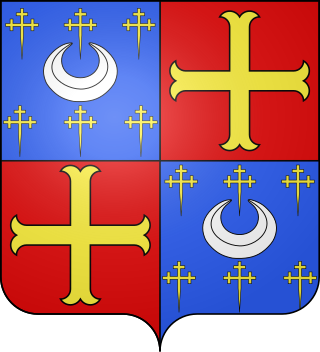Related Research Articles

The Battle of Crécy took place on 26 August 1346 in northern France between a French army commanded by King Philip VI and an English army led by King Edward III. The French attacked the English while they were traversing northern France during the Hundred Years' War, resulting in an English victory and heavy loss of life among the French.

The Battle of Sluys, also called the Battle of l'Écluse, was a naval battle fought on 24 June 1340 between England and France. It took place in the roadstead of the port of Sluys, on a since silted-up inlet between Zeeland and West Flanders. The English fleet of 120–150 ships was led by Edward III of England and the 230-strong French fleet by the Breton knight Hugues Quiéret, Admiral of France, and Nicolas Béhuchet, Constable of France. The battle was one of the opening engagements of the Hundred Years' War.
The Battle of Halidon Hill took place on 19 July 1333 when a Scottish army under Sir Archibald Douglas attacked an English army commanded by King Edward III of England and was heavily defeated. The year before, Edward Balliol had seized the Scottish Crown from five-year-old David II, surreptitiously supported by Edward III. This marked the start of the Second War of Scottish Independence. Balliol was shortly expelled from Scotland by a popular uprising, which Edward III used as a casus belli, invading Scotland in 1333. The immediate target was the strategically-important border town of Berwick-upon-Tweed, which the English besieged in March.

The siege of Calais occurred at the conclusion of the Crécy campaign, when an English army under the command of King Edward III of England successfully besieged the French town of Calais during the Edwardian phase of the Hundred Years' War.
Dudo, or Dudon, was a Picard historian, and dean of Saint-Quentin, where he was born the 960s. He was an erudite scholar and he likely acquired his education in Liège or perhaps Laon. By 987, Dudo had become a canon at St Quentin, the abbacy of which was held by the counts of Vermandois. In that year he was sent on a diplomatic mission to Richard I of Normandy by Albert I, Count of Vermandois which was successful. Dudo became a frequent visitor to the Norman court in the two years prior to Richard's death in 996. In a letter to Adalbero, Bishop of Laon, Dudo said that, as a result, Richard asked him to write a work recording "the customs and deeds of the Norman Land, the rights established within the kingdom of his great-grandfather Rollo". During a second stay in Normandy, Dudo wrote his history of the Normans, a task which Duke Richard had urged him to undertake. Very little else is known about his life, except that he died before 1043.

Robert of Torigni or Torigny, also known as Robert of the Mont, was a Norman monk, prior, and abbot. He is most remembered for his chronicles detailing English history of his era.

John II of Luxembourg, Count of Ligny was a French nobleman and soldier, a younger son of John of Luxembourg, Lord of Beauvoir, and Marguerite of Enghien. His older brother Peter received his mother's fiefs, including the County of Brienne, while John received Beaurevoir. He married Jeanne de Béthune, Viscountess of Meaux, widow of Robert of Bar, on 23 November 1418, and became step-father to Jeanne de Bar, Countess of Marle and Soissons. He and Jeanne de Béthune had no children.

Prémontré Abbey was the mother house of the Premonstratensian Order and was located at Prémontré about twelve miles west of Laon, département of Aisne, France.

The Diocese of Soissons, Laon, and Saint-Quentin is a Latin Church diocese of the Catholic Church in France. The diocese is suffragan to the Archdiocese of Reims and corresponds, with the exception of two hamlets, to the entire Department of Aisne. The current bishop is Renauld Marie François Dupont de Dinechin, appointed on 30 October 2015. In 2022, in the Diocese of Soissons there is one priest for every 5,594 Catholics.
The Treaty of Melun was signed in April 1226 between Louis VIII of France and Joan, Countess of Flanders.
Kelly Robert DeVries is an American medievalist and military historian specializing in the warfare of the Middle Ages. He is often featured as an expert commentator on television documentaries. He is professor of history at Loyola University Maryland and Honorary Historical Consultant at the Royal Armouries, UK.

Jean V de Bueil, called le Fléau des Anglais "plague of the English", was count of Sancerre, viscount of Carentan, lord of Montrésor, Château-en-Anjou, Saint-Calais, Vaujours, Ussé and Vailly, son of Jean IV de Bueil and Marguerite Dauphine of Auvergne. He is the author of Le Jouvencel (c. 1466), a semi-autobiographical roman a clef based on his experiences during the latter part of the Hundred Years War.

On 23 August 1328, the Battle of Cassel took place near the city of Cassel, 30 km south of Dunkirk in present-day France. Philip VI fought Nicolaas Zannekin, a wealthy farmer from Lampernisse. Zannekin was the leader of a band of Flemish rebels. The fighting erupted over taxation and punitive edicts of the French over the Flemish. The battle was won decisively by the French. Zannekin and about 3,200 Flemish rebels were killed in the battle.
The Battle of Arques was fought on 4 April 1303 in the French city of Arques between the County of Flanders and the Kingdom of France.

The Prophetiæ Merlini is a Latin work of Geoffrey of Monmouth circulated, perhaps as a libellus or short work, from about 1130, and by 1135. Another name is Libellus Merlini.
The Battle of Kinghorn was fought on 6 August 1332 at Wester Kinghorn, Fife, Scotland. An invading seaborne force of 1,500 men was commanded by Edward Balliol and Henry Beaumont, Earl of Buchan. A Scottish army, possibly 4,000 strong, commanded by Duncan, Earl of Fife, and Robert Bruce, Lord of Liddesdale was defeated with heavy loss. Balliol was the son of King John Balliol and was attempting to make good his claim to be the rightful king of Scotland. He hoped that many of the Scots would desert to him.
Oruç Bey was a 15th-century Ottoman historian.

The Abbey of St. Vincent, Laon was a Benedictine monastery in Laon, Picardy, northern France.

After the French lifted the siege of Orléans and won a decisive victory at the Battle of Patay, the English and Burgundians no longer posed a threat. Joan of Arc convinced the Dauphin Charles to go to Reims for his coronation. Successfully marching their army though the heart of territory held by the hostile Burgundians solidified the Dauphin’s regrasp of the throne of France. He had been disinherited from it through the Treaty of Troyes.
The Battle of Botora was fought between the armies of the Kingdom of Georgia and the Seljuk Empire on February 14, 1120.
References
- ↑ Jean Desnouelles (Abbot of St. Vincent, Laon.) (1855). Extraits de la chronique . Retrieved 30 April 2012.
- ↑ De Re Militari (Organization); Bernard S. Bachrach; Clifford J. Rogers; Kelly DeVries (30 June 2004). The Journal of Medieval Military History. Boydell Press. p. 8. ISBN 978-1-84383-040-5 . Retrieved 30 April 2012.
- ↑ DeVries, Kelly (1996). Infantry Warfare in the Early Fourteenth Century: Discipline, Tactics, and Technology. Boydell & Brewer Ltd. p. 40. ISBN 978-0-85115-571-5 . Retrieved 30 April 2012.
- ↑ Kooper, Erik (2008). The Medieval Chronicle V. Rodopi. p. 97. ISBN 978-90-420-2354-3 . Retrieved 30 April 2012.